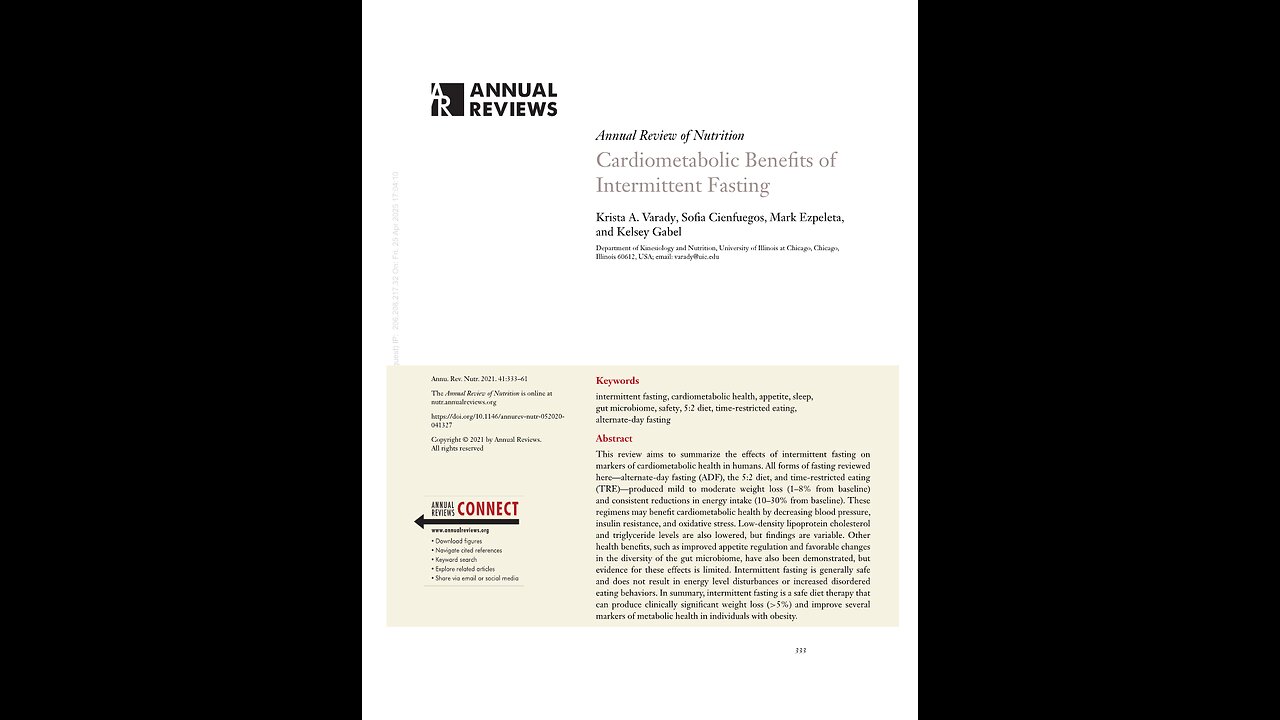Premium Only Content

Cardiometabolic Benefits of Intermittent Fasting. K. Varady, 2021. A Puke(TM) Audiopaper
Index of Other Science Articles:
https://rumble.com/v3t4yzj-index-of-science.-music-by-dan-vasc.html
Annual Review of Nutrition.
Cardiometabolic Benefits of Intermittent Fasting.
Krista Varady, Sofia Cienfuegos, Mark Ezpeleta, and Kelsey Gabel.
Department of Kinesiology and Nutrition, University of Illinois at Chicago.
https://www.annualreviews.org/content/journals/10.1146/annurev-nutr-052020-041327
Keywords. intermittent fasting, cardiometabolic health, appetite, sleep, gut microbiome, safety, 5 to 2 diet, time-restricted eating, alternate-day fasting
Abstract.
This review aims to summarize the effects of intermittent fasting on markers of cardiometabolic health in humans. All forms of fasting reviewed here, alternate-day fasting (ADF), the 5 to 2 diet, and time-restricted eating, T R E, produced mild to moderate weight loss, 1 to 8 percent from baseline, and consistent reductions in energy intake, 10 to 30 percent from baseline. These regimens may benefit cardiometabolic health by decreasing blood pressure, insulin resistance, and oxidative stress. Low-density lipoprotein cholesterol and triglyceride levels are also lowered, but findings are variable. Other health benefits, such as improved appetite regulation and favorable changes in the diversity of the gut microbiome, have also been demonstrated, but evidence for these effects is limited. Intermittent fasting is generally safe and does not result in energy level disturbances or increased disordered eating behaviors. In summary, intermittent fasting is a safe diet therapy that can produce clinically significant weight loss, greater than 5 percent, and improve several markers of metabolic health in individuals with obesity.
INTRODUCTION.
Intermittent fasting has emerged as one of the most popular diets for weight loss in recent years. The diet can be defined, in basic terms, as periods of eating alternated with periods of not eating. One reason for the rapid rise in popularity of intermittent fasting may be its sheer simplicity. This regimen does not require individuals to massively overhaul their current eating patterns or switch out all foods in their pantries. Moreover, intermittent fasting does not necessitate individuals to avoid food groups or specific macronutrients, nor does it require participants to vigilantly monitor calories day in, day out. These features can greatly increase the tolerability of the diet and may be why these regimens have become so widely adopted.
Despite the growing popularity of intermittent fasting, only a handful of trials have examined the health benefits of these diets in humans. In general, these preliminary findings indicate that fasting may help with weight management and metabolic disease reduction. Some of the mechanisms by which intermittent fasting may improve metabolic health include reduced free radical production, augmented stress resistance, improved glucose regulation, and suppressed inflammation.
More recently, it has been shown that fasting may upregulate autophagy by decreasing the activity of the mammalian target of rapamycin (m TOR) protein synthesis pathway. These cell responses play a critical role in removing damaged molecules and recycling their components while reducing protein synthesis to conserve energy.
This review aims to summarize the effects of various fasting regimens, alternate-day fasting (ADF), the 5 to 2 diet, and time-restricted eating, T R E, on body weight and cardiometabolic disease risk factors in human subjects. In addition, the emerging role of intermittent fasting in modulating appetite, sleep, and the gut microbiome is discussed. Pertinent safety considerations are also discussed. The review concludes with some practical advice for clinicians and individuals by explaining how to implement these diets in everyday life.
Types of Intermittent Fasting.
Intermittent fasting is an umbrella term for three different diets: ADF, the 5 to 2 diet, and Time Restricted Eating, Figure 1. ADF typically involves a feast day alternated with a fast day. On the feast day, individuals are permitted to eat ad libitum, with no restrictions on types or quantities of food consumed.
On fast days, participants can choose to consume only water, which is referred to as zero-calorie ADF. Alternatively, individuals can consume around 25 percent of their energy needs (500 to 800 kcal) on the fast day, which is termed modified ADF. During modified ADF, the fast day meal can be eaten all at once or spread throughout the day without impacting weight loss success. The 5 to 2 diet, on the other hand, is a modified version of ADF that involves 5 feast days and 2 fast days per week.
Akin to ADF, individuals are permitted to eat ad libitum on the feast days. On fast days during the 5 to 2 diet, around 25 percent of energy needs (500 to 800 kcal) are typically consumed, and the fast days can be placed on consecutive or nonconsecutive days during the week. Time Restricted Eating, in contrast, differs from ADF and the 5 to 2 diet in that it requires individuals to fast for a short period of time every day. More specifically, Time Restricted Eating involves confining the eating window to a specified number of hours per day, usually 4 to 10 hours, and fasting with zero-calorie beverages, for example, water, black coffee, black tea, calorie-free beverages, for the remaining hours of the day. During the eating window, individuals do not need to count calories or monitor food intake in any way.
Methods: Human Trial Selection.
The primary purpose of this review is to summarize the health benefits of intermittent fasting in humans; no animal studies were included in our literature search. We conducted a Medline search
using the keywords “intermittent fasting,” “fasting,” “meal timing,” “meal frequency,” “intermittent energy restriction,” “alternate day fasting,” “5 to 2 diet,” “time restricted eating,” “time restricted feeding,” “clinical trial,” and “human.” Inclusion criteria for research articles were as follows:
(a) randomized controlled trials and nonrandomized trials,
(b) adult male and female participants, and
(c) end points that included changes in body weight and relevant risk markers of cardiovascular disease or diabetes. The following exclusion criteria were applied:
(a) cohort and observations studies,
(b) fasting performed as a religious practice (Islam or Seventh-Day Adventist), and
(c) trial durations of less than 1 week. Our search retrieved 15 human trials of ADF (Table 1), 5 trials of the 5 to 2 diet (Table 1), and 13 trials of Time Restricted Eating (Table 2).
EFFECTS OF INTERMITTENT FASTING ON BODY WEIGHT.
Alternate-Day Fasting.
Three human trials of zero-calorie ADF and 12 trials of modified ADF have evaluated the impact of these regimens on body weight (Table 1). Zero-calorie ADF produced weight loss of 3 percent to 8 percent over 3 to 8 weeks, and the degree of weight loss was proportional to the duration of the intervention.
Figure 1.
Types of intermittent fasting. This figure outlines the timing of food intake during alternate-day fasting, the 5 to 2 diet, and time-restricted eating, T R E, 8 hour Time Restricted Eating is shown here, on each day of the week. Periods of food intake are depicted with an apple icon.
Reductions in body weight achieved with modified ADF, 4 to 8 percent, appear to be on par with that of zero-calorie ADF over similar trial durations, 6 to 12 weeks. Longer durations of modified ADF (24 weeks) do not result in greater weight loss, 6 percent, suggesting that the weight loss efficacy of ADF may peak at 12 weeks.
Table 1, page one.
Alternate-day fasting and the 5 to 2 diet.
Effect on body weight and risk factors for cardiometabolic disease.
Columns listed are.
Subjects, Diet length, Design and intervention groups, Body weight, Energy intake, Blood pressure,
Plasma lipids of LDL, HDL, TG,
Fasting glucose, Fasting insulin, I R, I S, G T, A1c, Inflammation, Oxidative stress, and References
Table 1, page two.
Table 1, page three.
Table 1, page four, final page.
Table 2, page one.
Time-restricted eating. Effect on body weight and risk factors for cardiometabolic disease.
Columns listed are
Subjects, Diet length, Design and intervention groups, Body weight, Energy intake, Blood pressure,
Plasma lipids, subdivided into LDL, HDL, and TG,
Glucoregulatory factors, subdivided into Fasting glucose, Fasting insulin, I R, I S, G T, A1c,
Inflammation, Oxidative stress, and References
Table 2, page two.
Table 2, page three.
These diets appear to be effective for weight loss in normal-weight individuals and those with overweight or obesity.
Due to the paucity of data in this area, it remains unclear whether the rate of weight loss is greater in people with obesity than in those with normal weight. Both zero-calorie ADF and modified ADF decrease overall energy intake by 20 to 35 percent. Participants following ADF typically do not overeat or binge on feast days. Accumulating evidence suggests that subjects typically consume only an additional 10 to 15 percent of energy needs, around 200 to 300 kcal, on feast days relative to their calculated energy needs. Because individuals do not fully compensate for lack of food consumed on the fast day by eating more on the feast day, energy restriction ensues, resulting in mild to moderate weight loss.
Three trials have compared the weight loss efficacy of ADF with that of traditional dieting, meaning daily calorie restriction (CR). After 8 to 24 weeks of treatment, the degree of weight loss achieved was not significantly different between ADF and CR groups, suggesting that these regimens are equally effective for reducing body weight.
To date, three trials have tested the weight maintenance efficacy of ADF. In each of these studies, participants continued a modified version of their ADF diet during the maintenance period. The weight maintenance version of ADF allowed for either greater energy consumption on the fast days (around 1,000 kcal) or fewer fast days per week. During the follow-up period (12 to 24 weeks), participants generally experienced mild weight regains (1 to 2 percent) relative to the end of the weight loss period. In view of this, it may be necessary for individuals to continue following a strict ADF approach, meaning 0 to 500 kcal on 3 to 4 fast days per week, to manage their weight long term with these diets.
The 5 to 2 Diet.
To date, five human trials have tested the effects of the 5 to 2 diet on body weight (Table 1). Fitzgerald et al evaluated the short-term weight loss efficacy of this diet and reported an average weight loss of 4 percent after 8 weeks of intervention. The other four trials examined the longer-term effects of the 5 to 2 diet and demonstrated weight loss of 7 percent after 24 to 52 weeks in men and women with overweight and obesity. Overall, the degree of weight loss achieved with the 5 to 2 diet in short-term and long-term trials seems comparable to that observed with ADF. Likewise, reductions in energy intake with the 5 to 2 diet and ADF also seem similar, with both therapies producing net energy deficits of 20 percent to 35 percent. These findings for body weight and energy restriction are somewhat surprising because subjects who participate in the 5 to 2 diet fast much less frequently, 2 fast days per week, than ADF participants do, 3 to 4 fast days per week.
Because more fast days per week do not seem to equate to greater energy restriction and weight loss, this puts into question whether ADF participants adhered to their prescribed protocol. It will be of interest for future trials to do a head-to-head comparison of ADF and the 5 to 2 diet to determine whether one diet is superior to the other in terms of compliance, energy restriction, and weight loss.
The efficacy of the 5 to 2 diet relative to daily CR (continuous energy restriction) was evaluated in all five of these studies. Findings from each trial report no significant difference in mean weight loss achieved with the 5 to 2 diet compared with daily CR over 8 to 52 weeks. Similar results were noted when ADF was compared with CR. In view of these findings, ADF and the 5 to 2 diet may be effective alternatives to traditional dieting and may be particularly appealing to those who struggle with restricting energy on a daily basis.
Only one of these trials tested the ability of the 5 to 2 diet to help individuals maintain weight loss. In the study by Sundfor et al, subjects fasted 2 days per week, around 500-kcal fast day, during a 24-week weight loss period followed by a 24-week weight maintenance period.
By the end of the weight loss period, body weight decreased by 8 percent from baseline. During the maintenance period, subjects regained approximately 1 percent of body weight, resulting in a net weight loss of 7 percent by the end of the trial. This trajectory of weight loss and regain is similar to that reported in longer-term ADF trials. As such, it can be speculated that the 5 to 2 diet and ADF impact body weight similarly over 1 year. Much more research is needed to test the weight maintenance efficacy of these diets. Well-designed randomized controlled trials that run for 2 to 3 years will be particularly important in helping assess the long-term feasibility and weight management efficacy of these fasting protocols.
Time-Restricted Eating.
To date, 13 human trials have examined the effects of Time Restricted Eating on body weight, Table 2). Although most of these studies allowed subjects to eat ad libitum during the eating window, some required subjects to consume their energy needs for weight maintenance throughout the trial. In this section, which focuses on weight loss and ad libitum energy intake, we discuss only the studies that allowed participants to eat freely during the eating window.
Two studies examined the effect of 4-hour Time Restricted Eating on body weight. In a randomized controlled trial by Cienfuegos et al, participants with obesity lost 3 percent of body weight after 8 weeks of 4-hour Time Restricted Eating, 3 to 7 PM. In contrast, Tinsley et al noted no change in body weight after 8 weeks of 4-hour Time Restricted Eating, 4 to 8 PM, 4 days per week, combined with resistance training in normal-weight men and women. The trial by Cienfuegos et al also implemented a 6-hour Time Restricted Eating arm. After 8 weeks of eating within a 6-hour window (1 to 7 PM, subjects lost similar amounts of weight, 3 percent, as the 4-hour Time Restricted Eating group, 3 percent. The effect of 8-hour Time Restricted Eating on body weight was investigated in five human trials. Anton et al, Gabel et al, and Chow et al demonstrated weight reductions of 2 percent to 4 percent in subjects with obesity after 4 to 12 weeks. In contrast, Tinsley et al noted increases in body weight (2 percent) in lean subjects when 8-hour Time Restricted Eating (12 to 8 PM) was combined with resistance training, and Lowe et al showed no weight loss versus controls. The impact of 9-hours and 10-hours Time Restricted Eating on body weight also has been evaluated. In the study by Hutchison et al, subjects with obesity and prediabetes participated in a crossover study that compared the effects of early 9-hour Time Restricted Eating (8 AM to 5 PM) and late 9-hour Time Restricted Eating (12 to 9 PM).
After 1 week of intervention, subjects lost 1 percent of body weight from baseline, and this effect did not vary according to the timing of the eating window, early versus late. In the studies of 10-hour Time Restricted Eating, subjects were permitted to self-select their eating windows. After 12 to 16 weeks of treatment, men and women with overweight lost 3 percent of body weight from baseline. In sum, Time Restricted Eating regimens with 4 to 10-hour eating windows generally produce weight reductions of 1 percent to 4 percent in subjects with overweight and obesity. Surprisingly, shorter eating windows, 4 and 6 hours, do not result in greater degrees of weight loss compared with longer eating windows, 8 and 10 hours.
Whether the timing of the eating window (early versus late) impacts weight loss is difficult to ascertain, as only one short-term study has directly tested this. When Time Restricted Eating is combined with exercise, specifically resistance training, the weight loss effects of the diet appear to be negated. This lack of effect could be due in part to increased appetite and energy consumption that sometimes occur with exercise, leading to weight maintenance or slight increases in body weight.
Most of these trials also assessed the impact of Time Restricted Eating on energy intake. Time Restricted Eating is a novel diet therapy in that it does not require subjects to count calories or monitor food intake. Subjects are simply required to eat within a specified time frame, and fast, with zero-calorie beverages permitted, throughout the rest of the day.
In reviewing the data in Table 2, it would appear as though confining the period of eating to 4 to 10 hour per day results in an unintentional reduction in energy intake ranging from 10 percent to 30 percent (200 to 600 kcal per day. From a clinical standpoint, these findings are paramount. A key reason for subject attrition during ADF and daily CR trials is having to carefully monitor energy intake on a regular basis.
Time Restricted Eating diets can sidestep this requirement, permitting participants to simply watch the clock instead of monitoring energy intake, and still produce significant weight loss. This unique feature of Time Restricted Eating has the potential to greatly increase long-term adherence to this protocol. Much more research in this emerging field is evidently needed. Specifically, controlled trials that assess the impact of Time Restricted Eating on body weight and energy intake over longer durations, 6 to 12 months, are well warranted.
Summary: Body Weight and Energy Intake.
In summary, the three major types of intermittent fasting, ADF, the 5 to 2 diet, and Time Restricted Eating, produce mild to moderate weight loss, 1 to 8 percent from baseline, in participants with overweight and obesity.
These regimens reduce energy intake by around 10 to 30 percent, which is on par with traditional CR. ADF and the 5 to 2 diet, but not Time Restricted Eating, are the only fasting approaches that produce clinically significant weight loss, greater than 5 percent from baseline. Practitioners should take this into consideration when recommending one approach over the other.
EFFECTS OF INTERMITTENT FASTING ON METABOLIC DISEASE RISK FACTORS.
Alternate-Day Fasting.
Several trials have evaluated the impact of ADF on blood pressure, Table 1. Zero-calorie ADF appears to have no effect on diastolic blood pressure but may lower systolic blood pressure, 5 percent. As for modified ADF, five trials demonstrate reductions in systolic, 5 to 11 percent, and diastolic, 5 to 10 percent, blood pressure, whereas four others show no effect.
All trials that demonstrate decreases in blood pressure involved participants with elevated blood pressure at baseline. Thus, it is possible that ADF lowers blood pressure only in those who have hypertension or borderline hypertension.
Changes in plasma lipids also are frequently assessed in human trials of ADF, Table 1. All three trials of zero-calorie ADF show significant decreases in low-density lipoprotein (LDL) cholesterol levels (10 to 23 percent. In contrast, only three modified ADF studies demonstrate reductions (8 to 25 percent) in LDL cholesterol. Due to the limited number of studies, it is difficult to ascertain whether this effect varies according to baseline LDL cholesterol level, body mass index (BMI) category, or intervention duration. High-density lipoprotein (HDL) cholesterol, by contrast, is slightly decreased or not affected by either zero-calorie or modified ADF. The only study that showed favorable increases in HDL cholesterol combined ADF with aerobic exercise. Because aerobic exercise increases HDL cholesterol, it is likely that this change is due to exercise training rather than fasting. Triglyceride levels were reduced in all zero-calorie ADF trials, 9 to 17 percent and in five of the modified ADF trials (13 to 42 percent. This effect was noted in several different population groups, including individuals with hypertriglyceridemia, normal triglyceride levels, obesity, and prediabetes. Longer durations of intermittent fasting did not seem to be related to greater reductions in triglyceride levels. Moreover, consuming a high-fat background diet, 45 percent of energy as fat, during ADF did not attenuate this beneficial effect.
The ability of ADF to modulate glycemic control also has been examined (Table 1). Zero calorie ADF appears to have little effect on fasting glucose, fasting insulin, and insulin sensitivity.
Fasting glucose also remained unchanged in the trials of modified ADF. This finding is not surprising, as circulating glucose levels are typically well controlled in subjects who do not have diabetes. Reductions in fasting insulin, 15 to 37 percent, were noted in many of the modified ADF trials but generally occurred only in subjects who had elevated insulin at baseline, greater than 13 micro international Units per mili-liter. Because higher levels of fasting insulin are an indicator of insulin resistance, ADF may produce this favorable effect only in those who display this condition. Circulating levels of HbA1c and insulin resistance did not change in any of the modified ADF trials reviewed here.
To date, two human trials have examined whether ADF produces changes in glucoregulation superior to those of CR. In the 8-week study by Parvaresh et al, fasting glucose was reduced only in the ADF group, 6 percent, with no change in the CR group. Complementary to these findings, Gabel et al performed a subanalysis of the trial by Trepanowski et al that included only participants with insulin resistance, defined as homeostatic model assessment for insulin resistance (HOMA-IR) greater than 2.7. After 6 months, both groups lost similar amounts of weight, but subjects in the modified ADF group demonstrated much greater reductions in fasting insulin (52 percent) and insulin resistance (53 percent) compared with subjects in the CR group (14 percent and 17 percent, respectively). Though the data are still limited, these preliminary findings suggest that ADF may be more effective than daily CR for lowering insulin resistance in participants at risk for developing diabetes.
The effects of ADF on circulating markers of inflammation and oxidative stress have been tested in a few human trials to date (Table 1). Overall, ADF appears to have little effect on the inflammatory markers C-reactive protein (CRP) and homocysteine. The study by Johnson et al was the only trial to demonstrate improvements in both inflammation and oxidative stress. After 8 weeks of modified ADF, tumor necrosis factor-alpha, TNF-alpha, a marker of inflammation, and several indicators of oxidative stress were reduced in subjects with obesity. More research is needed to determine whether ADF produces consistent improvements in markers of inflammation and oxidative stress.
The 5 to 2 Diet.
The impact of the 5 to 2 diet on blood pressure and plasma lipids was measured in all five human trials reviewed here (Table 1. Systolic and diastolic blood pressure were reduced (2 to 4 percent and 3 to 5 percent, respectively) after 24 to 48 weeks of intervention, and these decreases were comparable to those of CR (3 to 5 percent and 3 to 7 percent, respectively. LDL cholesterol and triglyceride concentrations were improved over time in two studies but, notably, did not decrease in the trials in which direct comparisons with controls were made. In studies of the 5 to 2 diet that observed significant changes, reductions in LDL cholesterol (10 to 12 percent) and triglycerides (12 to 16 percent) were on par with those of daily CR (9 to 12 percent and 10 to 15 percent, respectively. HDL cholesterol levels were slightly reduced (4 to 6 percent) over time in several of the longer-term studies of the 5 to 2 diet, 24 to 52 weeks. Similar reductions in HDL cholesterol levels by the 5 to 2 diet and daily CR were noted, which can be attributed to the nearly identical weight loss achieved. In comparing the 5 to 2 diet with ADF, both diets appear to produce similar reductions in blood pressure and plasma lipids. This finding puts into question whether ADF, meaning fasting almost twice as many days per week, offers any special benefit. It will be of interest to do a head-to-head comparison of these two fasting regimens to determine whether one diet is indeed superior to the other for improving metabolic health.
The effect of the 5 to 2 diet on glycemic control was assessed in all trials. In the studies that involved individuals without diabetes, fasting glucose levels generally remained unchanged.
In the study of the 5 to 2 diet by Harvie et al, insulin resistance decreased by 27 percent, which was significantly greater than that of CR (17 percent). These findings complement those of the ADF trial, which reported greater reductions in insulin resistance for the fasting group than for the daily CR group. The effects of the 5 to 2 diet on glycated hemoglobin levels were evaluated by Sundfor et al. After 48 weeks of intervention, HbA1c decreased from 5.6 percent to 5.3 percent, and this reduction was similar to that of daily CR.
Only one study examined how the 5 to 2 diet impacts glucoregulation in individuals with type 2 diabetes. In a 52-week study, Carter et al noted potent reductions in HbA1c (0.5 percent) with the 5 to 2 diet, which were comparable to those of CR (0.3 percent). This fasting approach also was safe in people with diet-controlled diabetes and in those who use medications that are not likely to cause hypoglycemia. Though the data are still limited, these preliminary findings bode well for the use of intermittent fasting in individuals with type 2 diabetes. These findings also suggest that fasting may be used as an alternative to CR to control HbA1c in patients with this condition.
A few studies have examined the effect of the 5 to 2 diet on markers of inflammation and oxidative stress. Although some minor reductions in CRP and advanced oxidation protein products, AOPP’s have been observed with the 5 to 2 diet, the data are far too limited to generate any solid conclusion yet.
Time-Restricted Eating.
The effects of Time Restricted Eating on parameters of cardiovascular health, meaning blood pressure and plasma lipid concentrations) have been evaluated in roughly half of the trials reported in Table 2. The effects of Time Restricted Eating on blood pressure are equivocal, with some studies reporting decreases in systolic (4 to 9 percent) and diastolic (7 to 9 percent) blood pressure and others reporting no effect. Notably, reductions in blood pressure occurred with varying lengths of eating windows, meaning 6-hours Time Restricted Eating, 8-hours Time Restricted Eating, and 10-hours Time Restricted Eating and also with and without weight loss.
LDL cholesterol levels remained unchanged in all trials, with the exception of the study by Wilkinson et al, who reported 12 percent reductions after 12 weeks of 10-hour Time Restricted Eating in subjects with metabolic syndrome. It is likely that greater weight loss (greater than 5 percent) would be required in order to observe consistent changes in LDL cholesterol with Time Restricted Eating. HDL cholesterol concentrations were not affected by any Time Restricted Eating intervention, even when Time Restricted Eating was combined with resistance training. Moderate-intensity resistance training generally increases HDL cholesterol levels in healthy individuals, so it is not clear why this lipid parameter remained unchanged in these studies. Triglyceride levels were largely unaltered by Time Restricted Eating, though two studies reported minor decreases of around 10 percent. The general lack of effect on triglycerides was noted with both shorter, 4-hour and 6-hour and longer, 8-hour and 10-hour eating windows. However, participants in most of these trials had triglyceride levels within the normal range at baseline, which may explain why little benefit was noted.
In the study by Sutton et al, triglyceride concentrations increased by 48 percent after 5 weeks of an early 6-hour Time Restricted Eating intervention, in which all food was consumed before 3 PM. Participants in the Sutton et al trial fasted for 18 hours before their blood draw, and subjects in the other Time Restricted Eating studies fasted for shorter durations (8 to 10 hours before testing. Acute fasting elevates circulating triglycerides and free fatty acid through augmented lipolysis. Thus, this spike in circulating triglyceride levels may be due to the acute effects of fasting rather than to the chronic effects of early 6-hour Time Restricted Eating.
The ability of Time Restricted Eating to improve glycemic control was tested in most of these trials (Table 2).
Fasting glucose levels remained unchanged by Time Restricted Eating, which is similar to that observed for ADF and the 5 to 2 diet.
Fasting insulin and insulin resistance decreased only with shorter eating windows of 4-hour and 6-hour Time Restricted Eating, and these effects were demonstrated in individuals without diabetes and in individuals with prediabetes. In addition, pancreatic beta-cell responsiveness was improved by early 6-hour Time Restricted Eating, all food was consumed before 3 PM. Longer eating windows, 8-hour and 10-hour Time Restricted Eating, had no effect on fasting insulin or insulin resistance. Thus, shorter eating windows, placed earlier in the day, may be required in order to improve parameters of glycemic control. Circulating concentrations of HbA1c did not change by 4-hour, 6-hour, or 10-hour Time Restricted Eating. However, changes in HbA1c are typically demonstrated only with clinically significant weight loss (greater than 5 percent, so it is likely that the degree of weight reduction in these studies, around 3 percent was not sufficient to change this parameter. Several trials have measured the effects of Time Restricted Eating on markers of inflammation. Overall, Time Restricted Eating had no effect on circulating levels of TNF-alpha, interleukin (IL)-6, CRP, or homocysteine, and this lack of effect was noted with both shorter (4-hour and 6-hour and longer 8-hour and 10-hour eating windows. Although Time Restricted Eating appears to have little effect on inflammation, it does seem to produce consistent reductions in markers of oxidative stress. For instance, 8-isoprostane which is a marker of oxidative stress to lipids, was reduced by 14 to 37 percent after 5 to 8 weeks of 4-hour and 6-hour Time Restricted Eating. The reductions in oxidative stress are likely related to improvements in insulin resistance by 4-hour and 6-hour Time Restricted Eating. Insulin signaling is impaired during oxidative conditions, which leads to insulin resistance of the cell. Moreover, insulin sensitivity improves when antioxidants such as vitamin E are administered. Therefore, one of the mechanisms by which Time Restricted Eating could improve insulin resistance is by decreasing oxidative stress.
Summary: Risk Factors for Metabolic Disease.
Taken together, all three types of intermittent fasting (ADF, the 5 to 2 diet, and Time Restricted Eating) modestly reduced systolic and diastolic blood pressure, shown in Figure 2. As for plasma lipids, ADF and the 5 to 2 diet lowered LDL cholesterol and triglyceride concentrations, but results were highly variable. Time Restricted Eating, by contrast, did not improve either LDL cholesterol or triglycerides, though it is likely that not enough weight loss was achieved during these short-term Time Restricted Eating studies to observe an effect. HDL cholesterol did not change with any fasting regimen. Fasting glucose levels were not altered by ADF, the 5 to 2 diet, or Time Restricted Eating. All of these intermittent fasting regimens showed promise in lowering fasting insulin, insulin resistance, and HbA1c in healthy individuals with obesity and in healthy individuals with prediabetes. Patients with type 2 diabetes also show improved glycemic control with the 5 to 2 diet, though much more research on this population group is still required. Circulating inflammatory markers, such as TNF-alpha, IL-6, CRP, and homocysteine, generally remained unchanged, though potent reductions in oxidative stress were noted in some studies of ADF and Time Restricted Eating. In summary, ADF, the 5 to 2 diet, and Time Restricted Eating may improve cardiometabolic health by lowering blood pressure, insulin resistance, and oxidative stress, but their ability to improve plasma lipids and markers of inflammation remains uncertain.
OTHER HEALTH BENEFITS OF INTERMITTENT FASTING.
Appetite Regulation.
Intermittent fasting may improve appetite regulation in a way that promotes weight loss. To date, three short-term studies and one long-term study have evaluated this hypothesis.
In an 8-week ADF trial by Hoddy et al, subjective hunger remained unchanged and levels of fullness increased from baseline to posttreatment. These increases in fullness were paralleled by increases in peptide YY (PYY), a potent satiety hormone.
Figure 2.
Cardiometabolic benefits of intermittent fasting. Alternate-day fasting (ADF), the 5 to 2 diet, and time-restricted eating, T R E, reduce body weight, blood pressure, fasting insulin, and insulin resistance in adults with obesity. Circulating low-density lipoprotein (LDL) cholesterol and triglyceride levels are more consistently lowered by ADF and the 5 to 2 diet, and markers of oxidative stress are more consistently reduced by Time Restricted Eating.
Changes in fullness and PYY were not related to weight loss or resting metabolic rate at any time point, however. Bhutani et al reported similar findings. After 12 weeks of ADF, hunger remained unaffected and fullness significantly increased in subjects with obesity. No significant relationship between augmented fullness and weight loss was noted. Beaulieu et al compared the effects of ADF with those of daily CR on appetite after matched weight loss (5 percent from baseline). Hunger decreased similarly in both groups, but the satiety quotient remained unchanged. Only one trial has examined the long-term effects of ADF on appetite. A 12-month trial by Kroeger et al showed that suboptimal weight loss and poor dietary adherence during ADF were related to a lack of any beneficial change in appetite. Altogether, short-term studies of ADF demonstrate improvements in subjective appetite, increased fullness, most commonly, whereas long-term studies of ADF show no prolonged benefits in appetite regulation. Much more research is needed in this area. Future trials should evaluate how appetite may change over the course of a fast day during ADF. Because subjects typically consume only one 500-kcal meal on fast days, it will be of interest to determine how their levels of hunger and fullness change over the course of the day and how this change affects their compliance with the energy goal of the fast day. Moreover, studies that evaluate how the 5 to 2 diet and Time Restricted Eating impact appetite are undoubtedly needed, as no studies have been performed to date. Sleep
Whether intermittent fasting can improve sleep is of great interest. To our knowledge, no human trials to date have examined the effect of ADF or the 5 to 2 diet on sleep, but several studies have tested how Time Restricted Eating impacts sleep.
Change in sleep quality during Time Restricted Eating was tested in three of the Time Restricted Eating trials reviewed here. After 8 weeks of 4-hour or 6-hour Time Restricted Eating, sleep quality did not change in the study by Cienfuegos et al.
Similarly, Gabel et al observed no effect on sleep quality after 12 weeks of 8-hour Time Restricted Eating. Wilkinson et al also reported no change in sleep quality after 10 weeks of 10-hour Time Restricted Eating.
Although this preliminary evidence suggests that sleep quality is not affected by Time Restricted Eating, it should be noted that participants in these studies were primarily good sleepers at baseline. Thus, it is not surprising that their sleep quality did not further improve with the interventions.
Whether Time Restricted Eating alters sleep duration also has been evaluated. Cienfuegos et al noted no changes in sleep duration with 4-hour or 6-hour Time Restricted Eating. Likewise, sleep duration remained unchanged with 8-hour and 9-hour Time Restricted Eating. However, most of these participants had a mean sleep duration of around 7 hours per night, which is in line with the 7-hour minimum stipulated by the National Sleep Foundation.
That these subjects were already getting sufficient hours of sleep may explain why sleep duration was not affected by Time Restricted Eating. The impact of Time Restricted Eating on insomnia severity also has been assessed. Researchers have hypothesized that fasting for 2 to 3 hours before bedtime may improve sleep. More specifically, abstaining from eating fatty and acidic foods before bed may reduce acid reflux and nighttime heartburn, which could contribute to lower rates of insomnia. In the 6-hour Time Restricted Eating study by Cienfuegos et al, participants went from displaying subthreshold insomnia at baseline to having no clinically significant insomnia by the end of the 8-week trial. In contrast, 4-hour and 8-hour Time Restricted Eating had no effect on insomnia severity in subjects who did not have clinically significant insomnia at baseline.
Taken together, these findings suggest that mild weight loss with Time Restricted Eating does not affect sleep quality or sleep duration in subjects who already display healthy sleep habits. By contrast, Time Restricted Eating may help lessen insomnia severity in those afflicted by this condition. Much more research is needed to confirm these preliminary findings. In particular, studies examining the effects of various intermittent fasting strategies on sleep quality, sleep duration, and insomnia severity in those who have diagnosed sleep disorders are critically needed.
Gut Microbiome.
The gut microbiome plays an important role in obesity and weight control. The most dominant gut microbial phyla are Firmicutes and Bacteroidetes. A higher proportion of Firmicutes and a lower of proportion Bacteroidetes have been linked to increased obesity and metabolic disturbances in humans. Although the role of Firmicutes in obesity is still largely uncertain, these bacteria augment the gut’s ability to harvest more calories from each meal, which can contribute to weight gain. Accumulating evidence also suggests that low microbial diversity and richness are associated with obesity. To our knowledge, the effects of intermittent fasting on changes in the gut microbiome have been evaluated in only two human trials to date. In a study by Gabel et al, men and women with obesity participated in an 8-hour Time Restricted Eating regimen for 12 weeks. By the end of the trial, phylogenetic diversity of the gut microbiota remained unchanged despite weight reductions of 3 percent. Moreover, there were no significant alterations in the abundance of Firmicutes, Bacteroidetes, or any other phyla after 12 weeks of 8-hour Time Restricted Eating. More recently, Zeb et al examined how 8-hour Time Restricted Eating impacts gut microbiota in healthy men without obesity. After 4 weeks, Time Restricted Eating significantly increased gut microbial diversity, compared with controls, despite no change in body weight. Microbial diversity reflects the complexity of the microbial community, and higher diversity is associated with a healthier gut microbiome. In addition, Zeb et al found that the composition of the gut microbiome improved by increasing the relative abundance of Bacteroidetes. These increases in Bacteroidetes were associated with reductions in LDL cholesterol and triglyceride concentrations. Thus, Time Restricted Eating may improve the diversity and overall composition of the gut microbiome in lean healthy subjects, but it appears to have no effect in individuals with obesity.
Due to the limited evidence to date, it is difficult to draw any meaningful conclusions from these data. Longer-term and larger randomized controlled trials that test the effect of different forms of intermittent fasting on the gut microbiome in humans are well warranted.
SAFETY OF INTERMITTENT FASTING.
Intermittent fasting is generally regarded as an effective intervention for weight loss, but the safety of these diets has been questioned. For instance, concerns have been raised regarding increased occurrences of gastrointestinal issues, energy level disturbances, eating disorder symptoms, and hormone disruptions. Whether these diets negatively affect diet quality is also a concern.
Gastrointestinal Issues and Energy Level Disturbances.
Findings from human trials show that fasting generally does not produce any prolonged gastrointestinal adverse effects, such as constipation, diarrhea, nausea, dry mouth, or halitosis. However, early 6-hour Time Restricted Eating resulted in a few minor cases of vomiting and diarrhea. Contrary to expectations, intermittent fasting also does not result in augmented levels of irritability, fatigue, or dizziness, as demonstrated by several recent trials. Thus, findings to date show that intermittent fasting produces little or no gastrointestinal issues or energy level disturbances.
Eating Disorder Symptoms.
Fasting has been criticized for potentially increasing disordered eating behaviors. Recent data from studies of ADF and Time Restricted Eating show that these diets do not increase rates of depression, binge eating, purgative behavior, or fear of fatness. Indeed, one study showed that ADF may have small beneficial effects on body image perception. These findings for ADF are comparable to those for daily CR. For instance, restricting energy by 25 percent did not increase eating disorder symptoms and had no other harmful psychological effects in the Comprehensive Assessment of Long-term Effects of Reducing Intake of Energy (CALERIE) trial. Thus, intermittent fasting, like CR, does not increase eating disorder symptoms and has benign or beneficial effects on body image perception. It should be noted, however, that these studies excluded participants with a history of eating disorders. Whether intermittent fasting is safe in those with diagnosed eating disorders remains unknown.
Thyroid and Reproductive Hormone Disruptions.
Changes in thyroid hormone levels during fasting have been examined in healthy populations and in populations with subclinical hypothyroidism. Moro et al recruited young male athletes to participate in a trial of 8-hour Time Restricted Eating combined with resistance training. After 8 weeks, plasma total triiodothyronine (T3) decreased slightly, but no significant changes in thyroid stimulating hormone (TSH) were detected. No weight change was observed in these subjects. Changes in free thyroxin (fT4) were not reported, so it is difficult to ascertain whether Time Restricted Eating disrupted the T3 to fT4 ratio in these euthyroid subjects. Akasheh et al compared the effects of ADF with those of daily CR on thyroid levels in subjects with obesity and subclinical hypothyroidism. After 24 weeks, body weight was similarly reduced by ADF and CR (8 percent), and circulating fT4, T3, and TSH remained unchanged. These pilot data suggest that T3 levels may be slightly lowered in lean individuals during intermittent fasting, but these effects do not occur in individuals with obesity and subclinical hypothyroidism.
The impact of fasting on reproductive hormone levels also has been evaluated. Harvie et al reported no change in testosterone, androstenedione, dehydroepiandrosterone-sulfate, sex hormone binding globulin, or prolactin in premenopausal women after 24 weeks of the 5 to 2 diet.
In contrast, reductions in free and total testosterone concentrations were noted in young males after 8 weeks of 8-hour Time Restricted Eating in the study by Moro et al. The decreases in the anabolic hormone, testosterone, did not lead to any deleterious changes in body composition or compromises in muscular strength. The lack of data in this area makes it difficult to draw conclusions regarding the effect of fasting on reproductive health. Moreover, how these changes affect fertility remains unknown, as no studies have tested the effects of these diets on the ability of men and women to conceive children.
Diet Quality.
Restricting the eating window during Time Restricted Eating has been speculated to lead to increased consumption of energy-dense foods and compensatory drinking, meaning increased diet soda and caffeine intake. Changes in diet quality during 4-hour and 6-hour Time Restricted Eating were assessed by Cienfuegos et al. Intakes of sugar, saturated fat, cholesterol, and sodium were not significantly different in the 4-hour and 6-hour Time Restricted Eating groups, relative to controls, after 8 weeks. Fiber intake, however, was far below, around 10 to 15 grams per day, what is recommended, 25 to 38 grams per day in Time Restricted Eating subjects at baseline and post treatment. Insufficient fiber intake is also regularly reported in trials of ADF and the 5 to 2 diet. As for beverage intake, consumption of diet sodas, caffeinated beverages, meaning coffee, tea, and energy drinks, and alcohol did not differ among the 4-hour Time Restricted Eating, 6-hour Time Restricted Eating, and control groups after 8 weeks. Complementary to these findings, a yearlong ADF trial reported no change in beverage intake. These preliminary findings suggest that intermittent fasting does not produce adverse changes in diet quality or beverage intake. However, dietary counseling to increase fiber intake should be provided to subjects during intermittent fasting to ensure maintenance of bowel health.
Importantly, individuals should be mindful of their diet quality during intermittent fasting. It is true that these regimens ask individuals to focus more on meal timing rather than on the types of nutrients consumed. Nevertheless, clinicians should clearly indicate to their patients that the feasting window does not give the patient carte blanche to consume whatever they want without being mindful of the health implications. For these regimens to be sustainable solutions to improve health, individuals who fast intermittently should be encouraged to consume a diet high in fruits, vegetables, and whole grains and low in processed foods.
PRACTICAL CONSIDERATIONS.
This section summarizes some practical advice on how to start fasting regimens, and how to incorporate these approaches into everyday life. This section also offers advice on who should not use these diets for weight management.
Initial Adjustment Period.
For most individuals, it takes approximately 1 to 2 weeks to become fully adjusted to this new pattern of eating. Dizziness and constipation have been reported during the initial period, but these adverse effects usually subside by the second week of fasting. Headaches also are frequently reported during this initial period. Headaches are generally the result of insufficient water intake leading to dehydration, which can occur when food is being restricted. Increasing water intake, adding 1.5 Liters per day, may help individuals alleviate headaches during fasting.
Exercising While Fasting.
Contrary to popular belief, it is indeed possible to exercise while fasting. Several human trials that combined fasting with exercise have been performed. Subjects in these studies could perform moderate- to high-intensity endurance or resistance training during 12 to 36 hour periods of food abstention. Anecdotally, we have noticed that subjects in our studies feel a boost of energy on fast days, which is advantageous for those wishing to exercise. It is, however, recommended that individuals consume the fast day meal after the exercise session during ADF. A compensatory increase in energy intake can occur in some individuals postexercise.
Thus, saving the meal for after the exercise session may help individuals stay within the limits of their fast day calorie goal.
Diet Recommendations During Fasting.
Although there are no specific recommendations for types of foods consumed during intermittent fasting, it is always advisable to emphasize a diet high in fruits, vegetables, and whole grains. These foods can help fasting participants boost their fiber intake, which can help relieve the constipation that is occasionally noted during fasting. Avoiding ultraprocessed foods is also important. A diet high in processed foods can lead to increased ad libitum energy intake and weight gain compared with a diet high in unprocessed foods matched for energy.
Alcohol and Caffeine.
Alcohol is permitted during intermittent fasting. Nonetheless, consuming alcohol on fast days during ADF and the 5 to 2 diet is not recommended. Energy intake on fast days is quite limited (around 500 kcal), so it is advisable to spend those calories on healthy foods that will provide nutrients rather than on alcohol, which is nutritionally deplete. Caffeinated beverages are permitted during both fasting and eating windows. Accumulating evidence suggests that individuals do not significantly change their patterns of caffeinated beverage consumption during fasting compared with baseline. However, it may be worthwhile to limit caffeine intake to the morning and afternoon, so that it does not interfere with one’s ability to fall asleep in the evening.
Who Should Not Do Intermittent Fasting?
Intermittent fasting is not recommended for pregnant or lactating women, as no studies have been performed to evaluate the safety of these diets in these population groups. Children under the age of 12 should not participate in fasting. Whether intermittent fasting can help teenagers with obesity manage weight is still uncertain, but emerging evidence suggests that it may be safe and effective. Intermittent fasting is also not recommended for individuals with a history of eating disorders and those with a BMI less than 18.5. Shift workers may struggle with adhering to fasting regimens, as their schedules and eating patterns may change drastically from day to day. Time Restricted Eating may be difficult for those who need to take medications with food at regimented times in the day. Thus, clinicians should review the patient’s medication regimen before prescribing a particular fasting approach.
CONCLUSION.
This review summarizes the effects of various intermittent fasting strategies on cardiometabolic risk indicators in humans. All forms of fasting produced mild to moderate weight loss, 1 to 8 percent from baseline, and consistent reductions in energy intake, 10 to 30 percent. The effects of fasting on metabolic disease risk parameters are less clear.
Whereas consistent reductions in blood pressure were reported, less reliable findings were noted for plasma lipids. ADF and the 5 to 2 diet may decrease LDL cholesterol and triglyceride concentrations when clinically significant weight loss (greater than 5 percent from baseline) is achieved. Time Restricted Eating, by contrast, appears to have no effect on these lipid parameters, though this lack of effect could be due to the limited weight loss attained during short-term Time Restricted Eating trials. Fasting glucose levels remained unchanged, but all forms of fasting showed promise in lowering fasting insulin, insulin resistance, and HbA1c in healthy individuals with obesity and in healthy individuals with prediabetes. Plasma markers of inflammation, TNF-alpha, IL-6, CRP, and homocysteine, remained unaltered with fasting, though potent reductions in markers of oxidative stress were demonstrated with ADF and Time Restricted Eating.
Fasting also may have other health benefits. Some short-term studies indicate that ADF may improve subjective appetite by increasing fullness. It remains unclear, however, whether these improvements in appetite regulation promote sustained weight loss. Sleep quality, sleep duration, and insomnia severity generally remained unaffected by fasting, but these trials are limited in that they recruited individuals who were already healthy sleepers at baseline. Favorable changes in the diversity and overall composition of the gut microbiome have been demonstrated, but these pilot findings still require confirmation.
As for safety, very few adverse events during intermittent fasting have been reported. These diets do not increase disordered eating behaviors and have benign or beneficial effects on body image perception. Thyroid and reproductive hormone levels generally remain unaffected by fasting. Diet quality and beverage intake, meaning diet soda and caffeinated drinks, also are not negatively impacted by these diets. However, fiber intake may be insufficient during fasting, so it is advisable to recommend higher-fiber foods while following these protocols to promote bowel health.
In summary, intermittent fasting is a safe diet therapy that can produce clinically significant weight loss in individuals with overweight or obesity. These regimens may also improve some aspects of cardiometabolic health such as blood pressure, insulin resistance, and markers of oxidative stress. Due to the paucity of data, it remains unknown whether one of these diets, ADF, the 5 to 2 diet, or Time Restricted Eating, is more clinically effective than the others. Individuals should choose a fasting approach that they can most easily incorporate into their lifestyle to reap the benefits of fasting long term.
DISCLOSURE STATEMENT.
ACKNOWLEDGMENTS.
LITERATURE CITED.
-
 LIVE
LIVE
LFA TV
14 hours agoLIVE & BREAKING NEWS! | MONDAY 10/6/25
2,860 watching -
 1:01:43
1:01:43
Chad Prather
22 hours agoEven Now!! Is It Too Late For A Miracle?
27.9K20 -
 1:20:19
1:20:19
JULIE GREEN MINISTRIES
3 hours agoLIVE WITH JULIE
72.1K112 -
 LIVE
LIVE
The Bubba Army
2 days agoBad Bunny Disrespectful? - Bubba the Love Sponge® Show | 10/06/25
1,608 watching -
 2:00:52
2:00:52
BEK TV
3 days agoTrent Loos in the Morning - 10/06/2025
16.2K -
 1:21:55
1:21:55
Mike Rowe
4 days agoThis Is How We CHANGE Education Today | Meredith Olson #451 | The Way I Heard It
20.6K13 -
 1:18:46
1:18:46
Steve-O's Wild Ride! Podcast
3 days ago $2.01 earnedJacoby Shaddix Breaks Down Papa Roach Longevity | Wild Ride #269
19.4K4 -
 17:42
17:42
Nate The Lawyer
2 days ago $3.20 earnedHow A Criminal Illegal Alien Scammed His Way Into A $300k Government Job.
18.9K14 -
 28:46
28:46
DeVory Darkins
15 hours ago $18.67 earnedPritzker HUMILIATED after brutal fact check as Democrat candidate calls for political assassination
33.9K102 -
 19:54
19:54
Forrest Galante
12 hours agoPrivate Tour Of America's Best Marine Animal Facility
43.8K7
